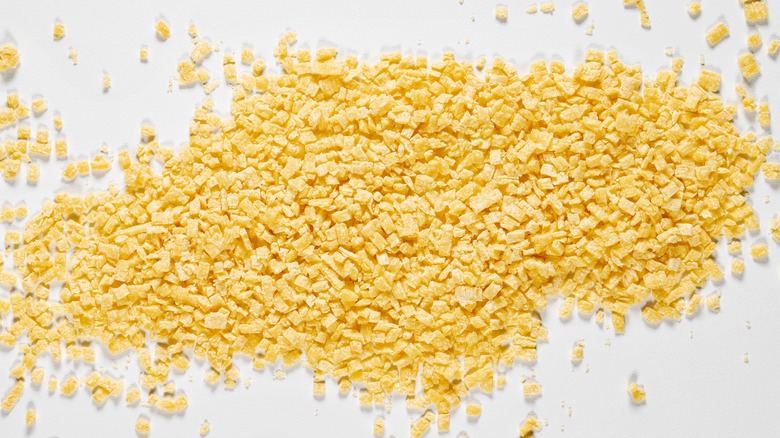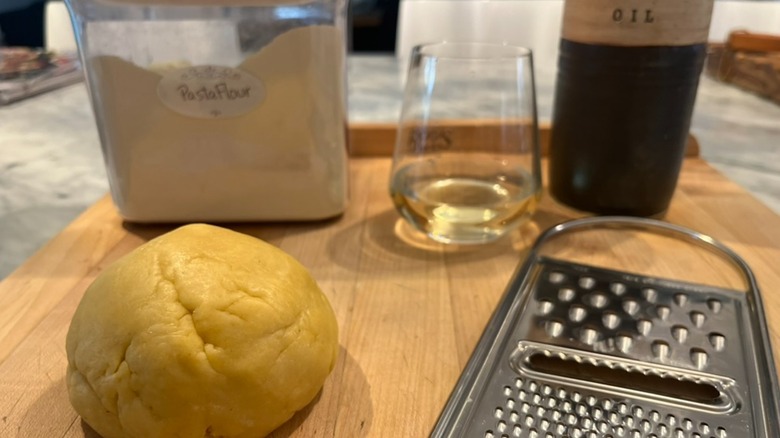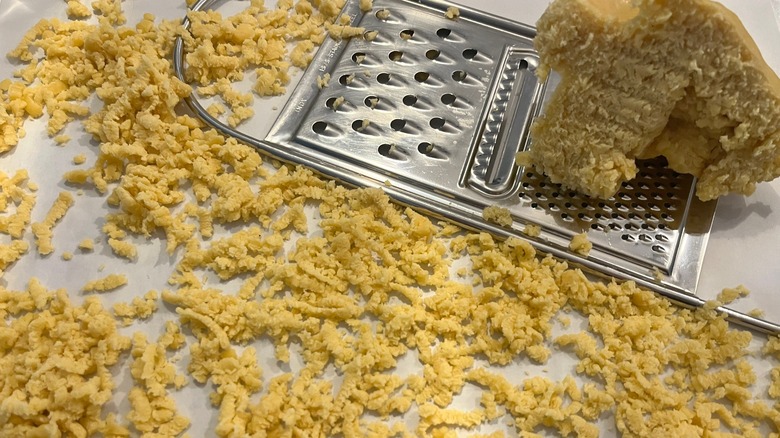Meet Grattini, The Silky Fresh Pasta For Soup Season
When sweater weather and soup season hits, grattini is a great companion. The small-shaped pasta can complement a number of broth-based soups made on repeat during the cold winter months. It's used similarly to orzo or ditalini in recipes like minestrone, and is part of pasta's pastina family, like the tiny star-shaped stelline.
Although less commonly found on shelves than more traditional pasta types, grattini (or grattoni for the larger version) can be purchased dried. However, making it from scratch is so easy that it's worth the effort. Unlike store-bought grattini, which is uniformly shaped, the homemade option is more ragged and uneven, which gives it a delightful mouthfeel.
Similar to German spaetzle, grattini is made from egg pasta dough. Its shape is created by scraping the dough against a grater (grattugia in Italian), which is how the name was derived. Its rustic form is traditionally shorter than spaetzle; however, increasing the pressure against the grater can create larger pasta pieces.
With a toothsome bite, grattini isn't only reserved for soup recipes. It's also delicious with stews and pasta sauces. And when you're under the weather, a bowl of grattini tossed in butter and sprinkled with grated Parmigiano-Reggiano is the ultimate comfort food. Here's how to make it at home.
How to make grattini
Grattini pasta dough can be made in a food processor, but kneading it by hand will help to get the texture right. The recipe calls for semolina and 'OO' flour, a finely ground type that delivers an elastic but tender texture. Like other pasta or bread recipes, the ingredient amounts are ultimately determined by the humidity in your kitchen and the size of the eggs, so use this recipe as a guide and adjust the quantities as necessary.
In a large bowl, combine 1 cup 'OO' flour, ½-cup of semolina flour, and 1 teaspoon Kosher salt. Mix in 1 tablespoon olive oil with a fork, followed by two large eggs. Once the dry dough comes together, dump it on the counter to knead.
If it's too dry, wet your hands with water and continue kneading until the dough is uniform in texture, although it will never be baby's bottom smooth. Form it into a ball and cover in plastic wrap to rest for at least 15 minutes.
Using the largest holes on a box grater, grate the dough onto a sheet pan, distributing the falling pasta into a single layer to avoid sticking. Allow the grattini to dry for an hour before adding it to simmering broth or boiling water to cook for roughly four minutes.
You may not need an entire pound as a soup addition, but once dried, grattini can be stored in the pantry or frozen for up to three months.
The history of grattini
Grattini was created centuries ago to salvage leftover scraps after making rolled pasta shapes like fettucini and stuffed pasta like ravioli. This frugal style of cooking, known as 'cucina povera' or poor kitchen, was used by Italian peasants to eliminate food waste and make the most of what was available.
Out of necessity, these home cooks took humble ingredients to create delicious, satisfying meals that we still enjoy today. Classic Italian recipes like ribollita and panzanella were invented to use stale bread that otherwise would've been thrown away.
Traditionally, grattini was made by cutting the pasta scraps with a knife into a small dice, similar in size to the soup's diced onions. To grate the dough replicates the shape quickly and doesn't require you to wait for leftovers.
Many cultures outside of Italy have similar recipes, like Germany's spaetzle and Slovenia's ribana kaša, and even within Italy, different regions have slight variations. Northern Italians traditionally add Parmesan cheese to grattini dough. Other regions may eliminate the eggs or vary the type of flour used for 'l'arte dell'arrangiarsi,' or the art of getting by with what you have on hand.



